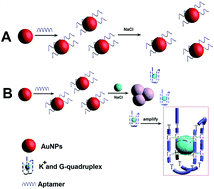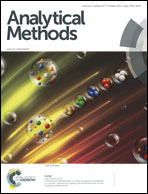A simple colorimetric sensor for potassium ion based on DNA G-quadruplex conformation and salt-induced gold nanoparticles aggregation†
Abstract
A simple colorimetric sensor for potassium ions (K+) based on DNA G-quadruplex conformation and salt-induced gold nanoparticle (AuNP) aggregation was developed. In the presence of K+ and NaCl, the conformation of the anti-K+ aptamer changed from a random coil structure to a G-quadruplex one, and this rigid G-quadruplex structure lost the ability to protect AuNPs from salt-induced aggregation; thus, the color change of AuNPs from wine red to blue could be observed by the naked eye. The aptasensor showed that the analytical linear range was from 1 μM to 1 mM and the detection limit was 0.42 nM. The presence of other metal ions did not affect the detection of K+, which indicated an excellent specificity of K+ detection. Rapidity, simplicity, high sensitivity and excellent selectivity made it suitable for practical use in determination of K+ in real urine samples.


 Please wait while we load your content...
Please wait while we load your content...